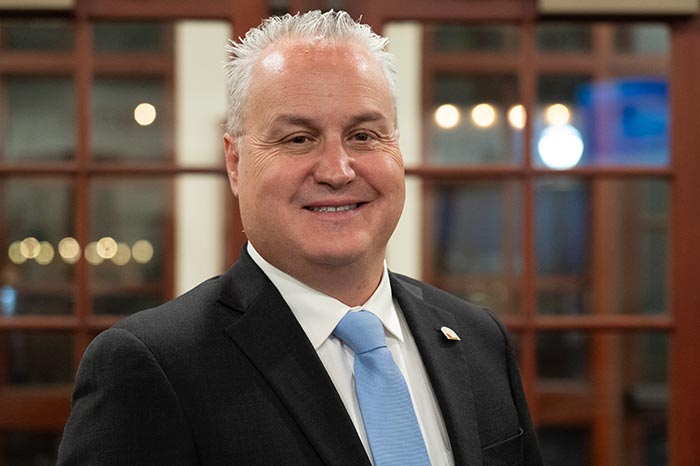2024 Claremont City Council candidate profile: Sal Medina

Claremont City Council District 5 incumbent and current Mayor Sal Medina faces longtime Claremont resident Kingoro Onami on November 5. Courier photo/Andrew Alonzo
by Andrew Alonzo | aalonzo@claremont-courier.com
Claremont City Council District 5 incumbent and current Mayor Silviano “Sal” Medina faces political newcomer and longtime Claremont resident Kingoro Onami in his bid for reelection on November 5.
Medina, 51, said having spent the last four years “learning from my colleagues and learning from other people that do this job well” make him especially qualified for another term. Additionally, Medina said his responsibilities as owner of Claremont’s Packing House Wines, as a former member of the Claremont Chamber of Commerce Board of Directors, and the University of La Verne’s Alumni Advisory Board, and as a former teacher helped him hone his leadership skills.
“Little things like that have allowed me to learn to lead over the last 30 years of life,” Medina said.
Housing is the biggest challenge facing the Claremont City Council, Medina said, one “every small city is encountering right now. A lot of that has to do with number one: coming to the realization that we have to develop, but the challenge there lies is how do we develop.” Questions to keep in mind during potential development processes are “How do we develop? How do we keep Claremont looking like Claremont? How do we keep Claremont charming, small, yet growing?” he said.
Housing has been a long running issue in Claremont and could still be 50 years down the road, he said. “But if we do it correctly, as we’ve done historically in town, Claremont will still keep its charm.”
Claremont is currently tasked by the state to reach its Regional Housing Needs Allocation of 1,711 new housing units — 556 extremely low-income units, 310 low income, 297 moderate income, and 548 above moderate-income units — by October 2029.
The goal “would be very difficult for any city to achieve given the factors that lead up into building those numbers,” including the cost of construction, employment, and contractors, and the city’s ability to identify labor and products, Medina said.
While not identifying housing zones puts Claremont at risk of sanctions from the state, finding such zones “shows that we’re moving on the right track with the expectation that we will build at some point,” Medina said.
“Unfortunately, cities across the state of California have not built at a rate in which the state has felt reasonable, and therefore they have imposed requirements on [cities] to build … at the level that they feel is acceptable,” he said. “Is it fair? Is it unfair? That’s, I think, the big divide. I think some people believe that the state shouldn’t tell cities what to do, but the state tells cities what to do all the time and we listen all the time. And this is just a matter of listening.”
Medina’s longstanding view on state mandated housing requirements is that the “development process should be a collaboration between city and state and or developers,” he wrote later in an email.
“Development is coming. It’s coming. Accept that. However, how development shows up is where I would like to have cities have more control,” he said. “That’s the concern that I have, is where the states have taken that away from cities. But I think, if state tells the cities or communities ‘You have to build this much,’ OK, let’s build it. But allow the cities to dictate what’s good for one city versus another city.
“To paint this blanket rule of thumb from a city like Anaheim versus a city like Claremont, a city like Long Beach versus a city like Sierra Madre, it’s unfair. Because those communities are distinctly different, and you need to allow those cities to continue to be distinctly different while having them build as the state is asking.”
Historically, Claremont has seen some opposition to new housing developments from residents. Medina said the key to getting everyone on board is communication.
“Build is required, if not, the city faces … possible sanctions from the state. But we just need to communicate to the residents that we’re required to build,” he said.
Medina said communicating to residents that what’s being built is desirable and meets the community standards is a good start. He cited the Olson Foothill Project as a prime example.
“It fits the street. It fits the neighborhood, and it has the needs of that development and the community in mind,” he said. “When somebody comes in and says, ‘We’re going to build a three-story house directly behind a single-story house with a 15-foot setback,’ that’s when neighbors get concerned.”
Asked what the current City Council does well, Medina said the five members “disagree well.”
“I don’t know which one of my colleagues said it, but they said, you know, we disagree, but we’re not disagreeable,” he said. “I think our council, as much as we may sit on opposite sides of whatever item is in front of us, we respect each other tremendously.
“We listen to each other. We listen to the community. We listen to people that come to the dais, and we take action on those things,” he said. “I know sometimes people will say, ‘Well, I’ve been asking for this for six months.’ The difficult thing is government moves glacially slow and I’m struggling with that.
“I think people sometimes think that just because action has not taken place, taken effect immediately, that we’re not listening, that we’re not behind the scenes working and we are.”
On the other side of the coin, Medina said the council could do better job communicating with constituents.
“I think in a past meeting someone had said ‘Those that are already engaged are already getting the information,’” he said. “How do we engage those that are not participating? To me, communication engagement is really what we need to really continue working on as a collective group in terms of not necessarily a flaw, but how we can be better.” One way he’s addressed the issue has been by meeting residents and business owners on their terms, in their spaces, and by helping young people understand government is accessible, he said.
Claremont City Council District 5 incumbent Sal Medina squares off with political newcomer Kingoro Onami on November 5. His campaign pages on Instagram and Facebook are viewable by searching “Sal Medina Claremont.”








0 Comments